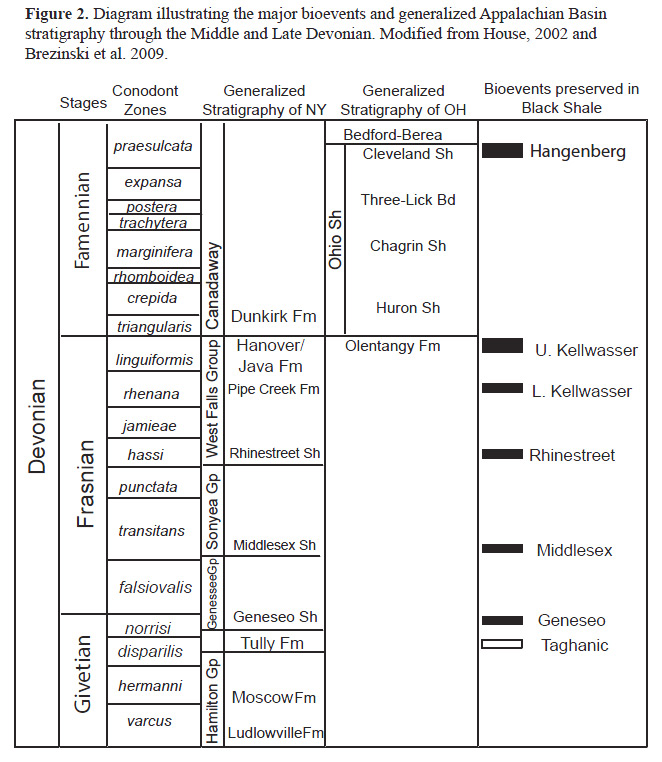57th Annual Report on Research 2012 Under Sponsorship of the ACS Petroleum Research Fund
Reports: UNI850400-UNI8: Testing the Extent of Anoxia in Late Devonian Aged Black Shales: A Multi-proxy Approach
Diana L. Boyer, PhD, State University of New York, at Oswego
Through the second year of the granting period significant advancements have been made in both field and laboratory work towards better understanding conditions surrounding the end Devonian mass extinction event. The primary goal of this research is to constrain in detail depositional conditions associated with one of the largest biotic turnovers in the history of life. Field research to acquire both paleontological and geochemical data has lead to high-resolution reconstruction of bottom water oxygen levels leading up to and through the Kellwasser Event, the interval associated with the extinction event. The primary findings completed thus far are that bottom water oxygen levels decreased dramatically below and then remained low leading up to the extinction interval, and that during the Kellwasser Event there is no evidence for persistent anoxia, rather that conditions were stressed, but fluctuating. During this past year a field trip guidebook was published (Boyer and Wooton, 2011), this research was presented at national and regional conferences (Boyer and Wilcox, 2011; Boyer, 2011; Seeger and Boyer, 2011) and at an invited research talk (Boyer at Hobart William Smith Colleges, April 2012). Two abstracts have been accepted to the national GSA conference in Nov. 2012 and a paper is also in preparation for submission to Geology.
Field Work
This past summer (June-August 2012) supplemental collections were continued on the Kellwasser interval (Hanover Formation) as well as overlying and underlying black shale intervals (Pipe Creek, Rhinestreet, Middlesex, Genesseeo black shales (Fig. 2)) in central and western New York for comparison. A total of 9 localities have been sampled continuously for analysis at the cm scale for both trace fossil composition and trace metals for this study. Further collections were made this summer in the interval below the Kellwasser event to capture conditions leading up to the mass extinction event.
Laboratory Work
During this past year intensive lab work has been completed with the aid of 3 undergraduate students (Seeger, St. Pierre, and Pratt). Samples from all collections have been cut, polished and photographed to expose ichnofabric details. The ichnofabric for four localities has been fully characterized. Over 150 samples, collected at the cm scale, have been powdered for geochemical analysis, and nearly 100 have been digested for processing in the ICP-MS. The results from the first 39 samples are discussed below.
Initial Results
This year has lead to the completion of trace fossil and geochemical data through the Kellwasser interval and surrounding sediments (cm scaled sampling through nearly 4 meters of section) in detail at 4 localities and on a broader scale at 5 more. These data support that the Kellwasser Event was not persistently anoxic. Specifically amount of bioturbation, quantified as ichnofabric indesx ranges from laminated (anoxic) through nearly fully bioturbated as ii4 (oxic/dysoxic) through these intervals and these values fluctuate over small stratigraphic scales (Fig. 1). Trace metal compositions as a redox proxy through this interval are rarely enriched (Fig. 1-Mo is shown as a well calibrated representative) consistent with oxic/dyoxic conditions and/or rapidly fluctuating conditions between anoxic and oxic. It is likely, based on the ichnological signal, that there is a background of anoxia with frequent short-lived pulses of oxygenation. I am currently collaborating with experts in biomarker analysis to finalize data analysis and produce a manuscript to disseminate these findings.

Figure 1-Stratigraphic, lithologic, ichnologic and geochemical data through the Upper Devonian in associate with Kellwasser Extinction event. Left most columns are stratigraphic descriptors. The lithologic column is labeled with burrows where significant. Notice gold colored burrows representing pyritized burrows associated with rapid deoxygenation event. Inchofabric index is used to quantify bioturbation and is correlated with relative bottom water oxygen levels. Mo concentrations are plotted against crustal values (red line) and interpretations of various levels of enrichment are labeled.
This year's work also focused on characterizing conditions leading into and out of the extinction event. The presence of abundant, vertical pyritized burrows at the base of a thin black shale just below the Kellwasser event, supports a rapid deoxygenation before the extinction event. Conditions return to bioturbated, but the absence of large preserved burrows and the preservation of specific trace fossils (i.e. Chondrites) suggest that oxygen levels remained low (dysoxic) and did not return to fully oxygenated leading up to the extinction event. Lithologic and other ichnological features support dynamic and fluctuating bottom water chemistry leading into the Kellwasser extinction event, with a sudden decrease in oxygen and then a slight increase before an extended period or fluctuating, but reduced oxygen levels. Large Thalassinoides type burrows piping into the Kellwasser event support a sudden return to fully oxygenated conditions. I am currently working on a manuscript to summarize these results and describe conditions leading up to this biotic turnover in hopes of constraining a kill mechanism.

Future Work
Samples have been collected for comparison with overlying and underlying shale samples, specifically associated with the Genesseo, Middlesex, Rhinestreet, Lower Kellwasser (Pipe Creek) and Hangenberg event (Fig 2). These units provide an essential comparison to the Upper Kellwasser Extinction horizon as background conditions and should allow for analysis of varying conditions in association with biotic turnovers of varying magnitude. Continued lab work will allow these questions to be addressed.










